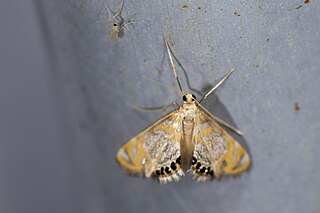
The Pyralidae, commonly called pyralid moths, snout moths or grass moths, are a family of Lepidoptera in the ditrysian superfamily Pyraloidea. In many classifications, the grass moths (Crambidae) are included in the Pyralidae as a subfamily, making the combined group one of the largest families in the Lepidoptera. The latest review by Eugene G. Munroe and Maria Alma Solis, in Kristensen (1999) retains the Crambidae as a full family of Pyraloidea.

Nymphula nitidulata, the beautiful china-mark, is a species of moth of the family Crambidae described by Johann Siegfried Hufnagel in 1767. It is found in Europe, Japan (Hokkaido), Turkey, Armenia, Russia and China.

Conogethes is a genus of moths in the subfamily Spilomelinae of the family Crambidae. The currently 17 recognized species are distributed in the Indomalayan and Australasian realm.

Eristena is a genus of moths of the family Crambidae.

Nymphicula is a genus of moths of the family Crambidae.
Paracataclysta is a monotypic moth genus in the family Crambidae described by Yutaka Yoshiyasu in 1983. Its single species, Paracataclysta fuscalis, was described by George Hampson in 1893. It is found in South-east Asia, northern Australia and Africa.

Paracymoriza is a genus of moths of the family Crambidae.

Parapoynx is a genus of moths of the family Crambidae described by Jacob Hübner in 1825.
Potamomusa is a genus of moths of the family Crambidae.

Austromusotima camptozonale, the climbing maidhair pyralid moth, is a moth of the family Crambidae. It is native to Australia, but attempts have been made to introduce it to southern Florida as a biological control agent for Old World climbing fern.
Siamusotima is a genus of moths of the family Crambidae. The genus was erected by Maria Alma Solis et al. in 2005.

Scirpophaga incertulas, the yellow stem borer or rice yellow stem borer, is a species of moth of the family Crambidae. It was described by Francis Walker in 1863. It is found in Afghanistan, Nepal, north-eastern India, Sri Lanka, Bangladesh, Myanmar, Vietnam, Thailand, Malaysia, Singapore, Sumatra, Java, Borneo, Sumba, Sulawesi, the Philippines, Taiwan, China and Japan.
Musotiminae is a subfamily of the lepidopteran family Crambidae. It was described by Edward Meyrick in 1884
Elophila fengwhanalis is a moth in the family Crambidae. It was described by Pryer in 1877. It is found in Japan, China and Korea.

Elophila nigralbalis is a moth in the family Crambidae. It was described by Aristide Caradja in 1925. It is found in Japan, Vietnam, Indonesia and Taiwan.
Elophila orientalis is a moth in the family Crambidae. It was described by Ivan Nikolayevich Filipjev in 1933. It is found in China, Japan and the Russian Far East (Ussuri).
Nymphula corculina is a moth in the family Crambidae. It was described by Arthur Gardiner Butler in 1879. It is found in Japan and the Russian Far East.
Lygomusotima constricta is a moth in the family Crambidae. It was described by Maria Alma Solis and Shen-Horn Yen in 2004. It is found in the Philippines (Luzon).
Lygomusotima stria is a moth in the family Crambidae. It was described by Maria Alma Solis and Shen-Horn Yen in 2004. It is found from Singapore and Thailand to Pulo Laut.
Neomusotima conspurcatalis is a moth in the family Crambidae. It was described by William Warren in 1896. It is found in India, Indonesia, East Timor and Australia.










